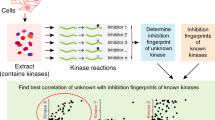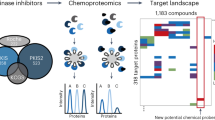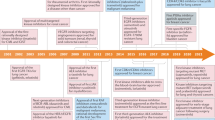Abstract
To fully exploit the potential of kinases as drug targets, novel strategies for the efficient discovery of inhibitors are required. In contrast to the traditional, linear process of inhibitor discovery, high-throughput kinase profiling enables a parallel approach by interrogating compounds against hundreds of targets in a single screen. Compound potency and selectivity are determined simultaneously, providing a choice of targets to pursue that is guided by the quality of lead compounds available, rather than by target biology alone.
This is a preview of subscription content, access via your institution
Access options
Subscribe to this journal
Receive 12 print issues and online access
$209.00 per year
only $17.42 per issue
Buy this article
- Purchase on Springer Link
- Instant access to full article PDF
Prices may be subject to local taxes which are calculated during checkout




Similar content being viewed by others
References
Schiffer, C. A. BCR–ABL tyrosine kinase inhibitors for chronic myelogenous leukemia. N. Engl. J. Med. 357, 258–265 (2007).
Baselga, J. Targeting tyrosine kinases in cancer: the second wave. Science 312, 1175–1178 (2006).
Collins, I. & Workman, P. New approaches to molecular cancer therapeutics. Nature Chem. Biol. 2, 689–700 (2006).
Sebolt-Leopold, J. S. & English, J. M. Mechanisms of drug inhibition of signalling molecules. Nature 441, 457–462 (2006).
Verweij, J. & de Jonge, M. Multitarget tyrosine kinase inhibition: [and the winner is...]. J. Clin. Oncol. 25, 2340–2342 (2007).
Boehm, J. S. et al. Integrative genomic approaches identify IKBKE as a breast cancer oncogene. Cell 129, 1065–1079 (2007).
Buckbinder, L. et al. Proline-rich tyrosine kinase 2 regulates osteoprogenitor cells and bone formation, and offers an anabolic treatment approach for osteoporosis. Proc. Natl Acad. Sci. USA 104, 10619–10624 (2007).
Carpten, J. D. et al. A transforming mutation in the pleckstrin homology domain of AKT1 in cancer. Nature 448, 439–444 (2007).
Davies, H. et al. Mutations of the BRAF gene in human cancer. Nature 417, 949–954 (2002).
Engelman, J. A. et al. MET amplification leads to gefitinib resistance in lung cancer by activating ERBB3 signaling. Science 316, 1039–1043 (2007).
Mahajan, N. P. et al. Activated Cdc42-associated kinase Ack1 promotes prostate cancer progression via androgen receptor tyrosine phosphorylation. Proc. Natl Acad. Sci. USA 104, 8438–8443 (2007).
Ruckle, T., Schwarz, M. K. & Rommel, C. PI3Kγ inhibition: towards an 'aspirin of the 21st century'? Nature Rev. Drug Discov. 5, 903–918 (2006).
Smith, W. W. et al. Kinase activity of mutant LRRK2 mediates neuronal toxicity. Nature Neurosci. 9, 1231–1233 (2006).
Soda, M. et al. Identification of the transforming EML4–ALK fusion gene in non-small-cell lung cancer. Nature 448, 561–566 (2007).
Strebhardt, K. & Ullrich, A. Targeting polo-like kinase 1 for cancer therapy. Nature Rev. Cancer 6, 321–330 (2006).
Tefferi, A. JAK2 mutations in polycythemia vera — molecular mechanisms and clinical applications. N. Engl. J. Med. 356, 444–445 (2007).
Tse, A. N., Carvajal, R. & Schwartz, G. K. Targeting checkpoint kinase 1 in cancer therapeutics. Clin. Cancer Res. 13, 1955–1960 (2007).
Hayashi, M. L. et al. Inhibition of p21-activated kinase rescues symptoms of fragile X syndrome in mice. Proc. Natl Acad. Sci. USA 104, 11489–11494 (2007).
Whartenby, K. A. et al. Inhibition of FLT3 signaling targets DCs to ameliorate autoimmune disease. Proc. Natl Acad. Sci. USA 102, 16741–16746 (2005).
Changelian, P. S. et al. Prevention of organ allograft rejection by a specific Janus kinase 3 inhibitor. Science 302, 875–878 (2003).
Solinas, G. et al. JNK1 in hematopoietically derived cells contributes to diet-induced inflammation and insulin resistance without affecting obesity. Cell Metab. 6, 386–397 (2007).
Morwick, T. et al. Evolution of the thienopyridine class of inhibitors of IκB kinase-β: part I: hit-to-lead strategies. J. Med. Chem. 49, 2898–2908 (2006).
Pevarello, P. et al. 3-Aminopyrazole inhibitors of CDK2/cyclin A as antitumor agents. 1. Lead finding. J. Med. Chem. 47, 3367–3380 (2004).
Wittman, M. et al. Discovery of a (1H-benzoimidazol-2-yl)-1H-pyridin-2-one (BMS-536924) inhibitor of insulin-like growth factor I receptor kinase with in vivo antitumor activity. J. Med. Chem. 48, 5639–5643 (2005).
Bach, S. et al. Roscovitine targets, protein kinases and pyridoxal kinase. J. Biol. Chem. 280, 31208–31219 (2005).
Bain, J. et al. The selectivity of protein kinase inhibitors: a further update. Biochem. J. 408, 297–315 (2007).
Bantscheff, M. et al. Quantitative chemical proteomics reveals mechanisms of action of clinical ABL kinase inhibitors. Nature Biotech. 25, 1035–1044 (2007).
Fedorov, O. et al. A systematic interaction map of validated kinase inhibitors with Ser/Thr kinases. Proc. Natl Acad. Sci. USA 104, 20523–20528 (2007).
Goldstein, D. M. & Gabriel, T. Pathway to the clinic: inhibition of P38 MAP kinase. A review of ten chemotypes selected for development. Curr. Top. Med. Chem. 5, 1017–1029 (2005).
Karaman, M. W. et al. A quantitative analysis of kinase inhibitor selectivity. Nature Biotech. 26, 127–132 (2008).
Manfredi, M. G. et al. Antitumor activity of MLN8054, an orally active small-molecule inhibitor of Aurora A kinase. Proc. Natl Acad. Sci. USA 104, 4106–4111 (2007).
Melnick, J. S. et al. An efficient rapid system for profiling the cellular activities of molecular libraries. Proc. Natl Acad. Sci. USA 103, 3153–3158 (2006).
Berman, E. et al. Altered bone and mineral metabolism in patients receiving imatinib mesylate. N. Engl. J. Med. 354, 2006–2013 (2006).
McDermott, U. et al. Identification of genotype-correlated sensitivity to selective kinase inhibitors by using high-throughput tumor cell line profiling. Proc. Natl Acad. Sci. USA 104, 19936–19941 (2007).
Seggewiss, R. et al. Imatinib inhibits T-cell receptor-mediated T-cell proliferation and activation in a dose-dependent manner. Blood 105, 2473–2479 (2005).
Force, T., Krause, D. S. & Van Etten, R. A. Molecular mechanisms of cardiotoxicity of tyrosine kinase inhibition. Nature Rev. Cancer 7, 332–344 (2007).
Verheul, H. M. & Pinedo, H. M. Possible molecular mechanisms involved in the toxicity of angiogenesis inhibition. Nature Rev. Cancer 7, 475–485 (2007).
Carter, T. A. et al. Inhibition of drug-resistant mutants of ABL, KIT, and EGF receptor kinases. Proc. Natl Acad. Sci. USA 102, 11011–11016 (2005).
Giles, F. J. et al. MK-0457, a novel kinase inhibitor, is active in patients with chronic myeloid leukemia or acute lymphocytic leukemia with the T315I BCR–ABL mutation. Blood 109, 500–502 (2007).
Joensuu, H. et al. Effect of the tyrosine kinase inhibitor STI571 in a patient with a metastatic gastrointestinal stromal tumor. N. Engl. J. Med. 344, 1052–1056 (2001).
Li, B., Liu, Y., Uno, T. & Gray, N. Creating chemical diversity to target protein kinases. Comb. Chem. High Throughput Screen. 7, 453–472 (2004).
Benson, J. D. et al. Validating cancer drug targets. Nature 441, 451–456 (2006).
Fitzgerald, J. B., Schoeberl, B., Nielsen, U. B. & Sorger, P. K. Systems biology and combination therapy in the quest for clinical efficacy. Nature Chem. Biol. 2, 458–466 (2006).
Smolen, G. A. et al. Amplification of MET may identify a subset of cancers with extreme sensitivity to the selective tyrosine kinase inhibitor PHA-665752. Proc. Natl Acad. Sci. USA 103, 2316–2321 (2006).
Kamb, A., Wee, S. & Lengauer, C. Why is cancer drug discovery so difficult? Nature Rev. Drug Discov. 6, 115–120 (2007).
Stommel, J. M. et al. Coactivation of receptor tyrosine kinases affects the response of tumor cells to targeted therapies. Science 318, 287–290 (2007).
Wood, E. R. et al. A unique structure for epidermal growth factor receptor bound to GW572016 (Lapatinib): relationships among protein conformation, inhibitor off-rate, and receptor activity in tumor cells. Cancer Res. 64, 6652–6659 (2004).
Caron, P. R. et al. Chemogenomic approaches to drug discovery. Curr. Opin. Chem. Biol. 5, 464–470 (2001).
Vieth, M. et al. Kinomics-structural biology and chemogenomics of kinase inhibitors and targets. Biochim. Biophys. Acta 1697, 243–257 (2004).
Stamos, J., Sliwkowski, M. X. & Eigenbrot, C. Structure of the epidermal growth factor receptor kinase domain alone and in complex with a 4-anilinoquinazoline inhibitor. J. Biol. Chem. 277, 46265–46272 (2002).
Knowles, P. P. et al. Structure and chemical inhibition of the RET tyrosine kinase domain. J. Biol. Chem. 281, 33577–33587 (2006).
Heron, N. M. et al. SAR and inhibitor complex structure determination of a novel class of potent and specific Aurora kinase inhibitors. Bioorg. Med. Chem. Lett. 16, 1320–1323 (2006).
Pandey, A. et al. Identification of orally active, potent, and selective 4-piperazinylquinazolines as antagonists of the platelet-derived growth factor receptor tyrosine kinase family. J. Med. Chem. 45, 3772–3793 (2002).
Liu, Y. & Gray, N. S. Rational design of inhibitors that bind to inactive kinase conformations. Nature Chem. Biol. 2, 358–364 (2006).
Pargellis, C. et al. Inhibition of p38 MAP kinase by utilizing a novel allosteric binding site. Nature Struct. Biol. 9, 268–272 (2002).
Shah, N. P. et al. Overriding imatinib resistance with a novel ABL kinase inhibitor. Science 305, 399–401 (2004).
Flaherty, K. T. Sorafenib in renal cell carcinoma. Clin. Cancer Res. 13, 747S–752S (2007).
Araujo, R. P., Liotta, L. A. & Petricoin, E. F. Proteins, drug targets and the mechanisms they control: the simple truth about complex networks. Nature Rev. Drug Discov. 6, 871–880 (2007).
Carmeliet, P. & Jain, R. K. Angiogenesis in cancer and other diseases. Nature 407, 249–257 (2000).
Schmit, T. L. & Ahmad, N. Regulation of mitosis via mitotic kinases: new opportunities for cancer management. Mol. Cancer Ther. 6, 1920–1931 (2007).
Acknowledgements
We thank S. Herrgard for creating figures, N. Lydon for helpful discussions, M. Williams for suggesting this article, and W. Wierenga, S. Bhagwat, S. Keane, D. Treiber, Y. Liu and U. Eggert for their critical reading of the manuscript. The phylogenetic tree of the human kinome in Boxes 1 and 2 is used with permission from Science and Cell Signaling Technology, Inc.
Author information
Authors and Affiliations
Corresponding author
Ethics declarations
Competing interests
Patrick Zarrinkar is an employee of Ambit Biosciences. Nathanael Gray receives research funding from Novartis.
Related links
Rights and permissions
About this article
Cite this article
Goldstein, D., Gray, N. & Zarrinkar, P. High-throughput kinase profiling as a platform for drug discovery. Nat Rev Drug Discov 7, 391–397 (2008). https://doi.org/10.1038/nrd2541
Issue Date:
DOI: https://doi.org/10.1038/nrd2541
This article is cited by
-
Large-scale comparison of machine learning methods for profiling prediction of kinase inhibitors
Journal of Cheminformatics (2024)
-
Identification of MMP1 as a potential gene conferring erlotinib resistance in non-small cell lung cancer based on bioinformatics analyses
Hereditas (2020)
-
Identification and characterization of the Cucurbitacins, a novel class of small-molecule inhibitors of Tropomyosin receptor kinase a
BMC Complementary and Alternative Medicine (2019)
-
Kinase inhibitors: the road ahead
Nature Reviews Drug Discovery (2018)



